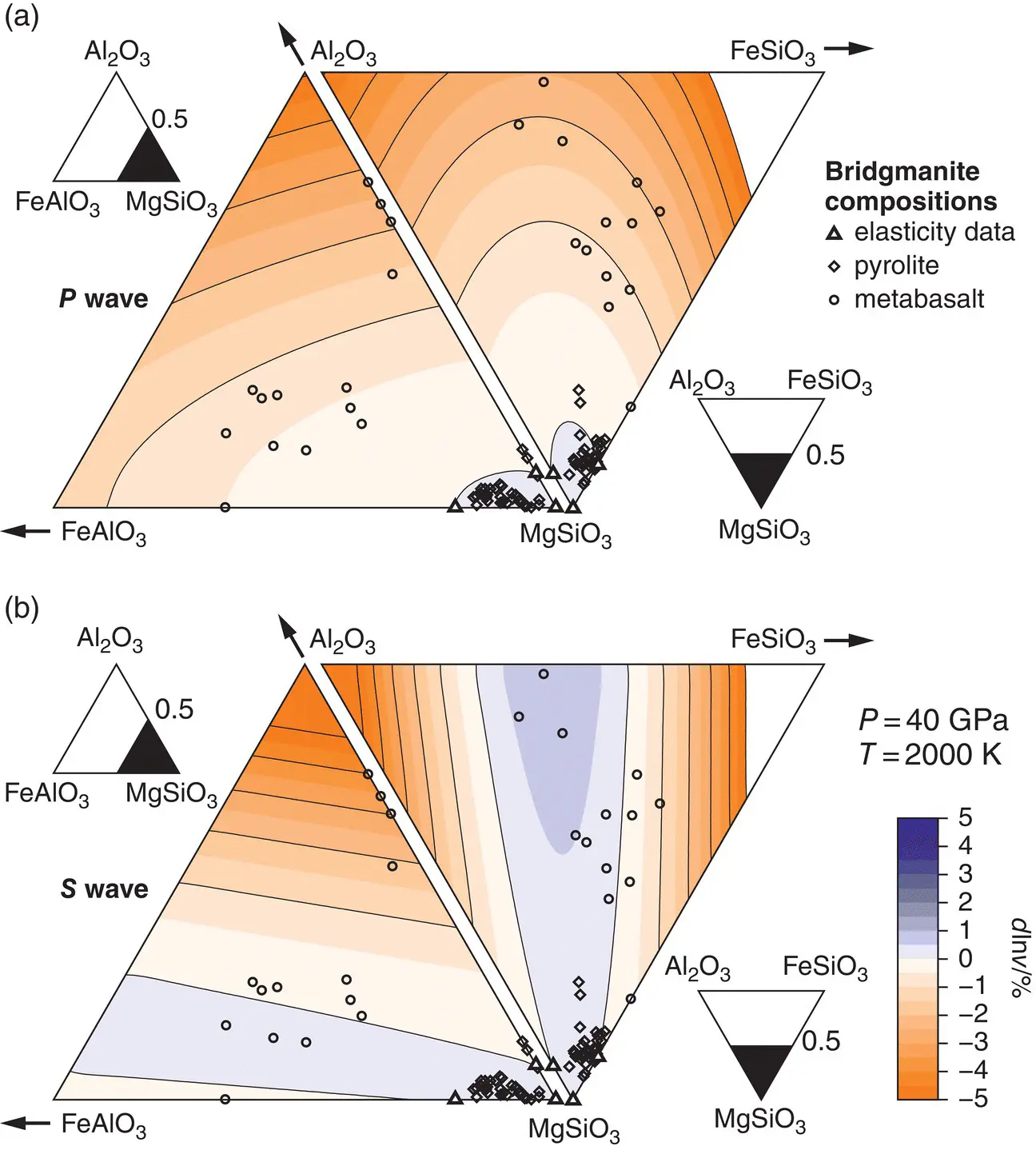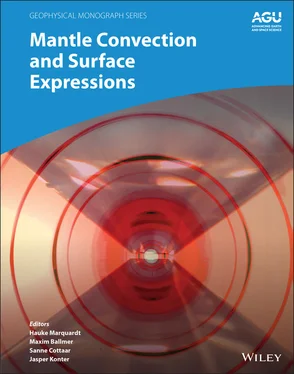
Figure 3.3 Variations in P -wave (a) and S -wave (b) velocities of bridgmanite solid solutions at 40 GPa and 2000 K that reflect the differences between the Voigt and Reuss bounds when combining the elastic properties of bridgmanite compositions (triangles). Each large ternary diagram spans the section marked black in the small full ternary diagram next to each large ternary diagram. See Table 3.1for references to finite‐strain parameters for bridgmanite compositions (triangles) and Figure 3.6for references to mineral compositions observed in experiments on different bulk rock compositions (circles and diamonds).
In addition to mapping uncertainties on modeled sound wave velocities, Figure 3.3summarizes bridgmanite compositions observed in experiments on bulk rock compositions of interest for Earth’s lower mantle. Many of these compositions, in particular for metabasaltic rocks, fall outside the compositional limits defined by bridgmanite compositions for which elastic properties have been determined in experiments. This highlights the need for further studies on the elastic properties of bridgmanite solid solutions to expand compositional limits, to establish reliable trends for individual substitution mechanisms, and to resolve inconsistencies between experiments and computations. Although I focused on bridgmanite solid solutions as they are of highest relevance for the lower mantle, there is a similar need to systematically analyze and describe the effect of chemical composition on the elastic properties of other chemically complex mantle minerals such as garnets, pyroxenes, and the calcium ferrite‐type aluminous phase. Internally consistent thermodynamic databases on mantle minerals provide highly valuable resources for end member properties (Holland et al., 2013; Komabayashi & Omori, 2006; Stixrude & Lithgow‐Bertelloni, 2011, 2005). To date, however, these databases do not include all relevant end members and/or do not include shear properties. Internally consistent thermodynamic properties of hydrous high‐pressure phases, for example, have been derived for magnesium end members only (Komabayashi and Omori, 2006). Recent experimental results on the elastic properties of wadsleyite and ringwoodite allowed for modeling the combined effects of iron and hydrogen on sound wave velocities in the mantle transition zone (Buchen et al., 2018b; Schulze et al., 2018). When sufficient data on intermediate compositions of a complex solid solution are available, it might be possible to determine end member properties by making assumptions about how end member elastic properties combine to those of intermediate compositions. Although restricted to the equation of state, Buchen et al. (2017) devised models for wadsleyite solid solutions in the system Mg 2SiO 4‐Fe 2SiO 4‐MgSiO 2(OH) 2‐Fe 3O 4by assuming solid solutions between end members to follow either the Reuss or the Voigt bound when mixing the properties of end members. In principle, such an approach can be extended to shear properties and other minerals once sufficient data become available.
3.7 ELASTIC ANOMALIES FROM CONTINUOUS PHASE TRANSITIONS
The finite‐strain formalism outlined in Section 3.2describes a smooth variation of elastic properties and pressure with finite strain and temperature. Phase transitions interrupt these smooth trends as, at the phase transition, a new phase with different elastic properties becomes stable. The series of phase transitions in (Mg,Fe) 2SiO 4compounds from olivine ( α ) to wadsleyite ( β ) to ringwoodite ( γ ), for example, results in abrupt changes of elastic properties and density when going from one polymorph to another. Such abrupt changes in elastic properties typically result from first‐order phase transitions that involve a reorganization of the atomic structure of a compound. The elastic properties of the compound are then best described by constructing a finite‐strain model for each polymorph. If the phase transition consists of a gradual distortion of the crystal structure, for example by changing the lengths or angles of chemical bonds, the elastic properties and density of the compound may vary continuously across the phase transition. In this case, it is often possible to describe the effect of the phase transition by adding an excess energy contribution to the energy of the undistorted phase. The changes in elastic properties that result from the phase transition can then be calculated from the excess energy and added to the finite‐strain contribution of the undistorted phase.
Ferroelastic phase transitions are a common type of continuous phase transitions that can lead to substantial anomalies in elastic properties (Carpenter & Salje, 1998; Wadhawan, 1982). Upon cooling or compression across the transition point, a high‐symmetry phase spontaneously distorts into a phase of lower crystal symmetry. Along with the reduction in symmetry, the crystallographic unit cell changes shape, giving rise to spontaneous strains that describe the distortion of the low‐symmetry phase with respect to the high‐symmetry phase. Many minerals undergo ferroelastic distortions including the high‐pressure phases stishovite (Andrault et al., 1998; Carpenter et al., 2000; Karki et al., 1997b; Lakshtanov et al., 2007) and calcium silicate perovskite (Gréaux et al., 2019; Shim et al., 2002; Stixrude et al., 2007; Thomson et al., 2019). The excess energy associated with ferroelastic phase transitions can be described using a Landau expansion for the excess Gibbs free energy (Carpenter, 2006; Carpenter & Salje, 1998):


The first part of this expansion gives the energy contribution that arises from structural rearrangements which drive the phase transition. These rearrangements may be related to changes in the ordering of cations over crystallographic sites, in the vibrational structure, or in other properties of the atomic structure. The progress or extent of these rearrangements is captured by the order parameter Q . The last term gives the elastic energy associated with distorting the high‐symmetry phase with the elastic stiffness tensor  into the low‐symmetry phase according to the spontaneous strains e ij. Coupling between the order parameter Q and the spontaneous strains e ijis taken into account by the central term with coupling coefficients λ ij,m,n. The exact form and order of the coupling terms follow strict symmetry rules (Carpenter et al., 1998; Carpenter & Salje, 1998).
into the low‐symmetry phase according to the spontaneous strains e ij. Coupling between the order parameter Q and the spontaneous strains e ijis taken into account by the central term with coupling coefficients λ ij,m,n. The exact form and order of the coupling terms follow strict symmetry rules (Carpenter et al., 1998; Carpenter & Salje, 1998).
In the high‐symmetry phase, Q = 0 and e ij= 0 so that the excess energy vanishes. At the transition point, the high‐symmetry phase spontaneously distorts to the low‐symmetry phase, and both the order parameter and the spontaneous strains evolve away from zero. By following a sequence of thermodynamic arguments, expressions for the variation of the order parameter Q , the spontaneous strains e ij, and individual components of the elastic stiffness tensor c ijklwith pressure and temperature can be derived (Carpenter & Salje, 1998). These expressions can be used to analyze experimentally observed or computed spontaneous strains or elastic properties to constrain the parameters A , B , ⋯ and the coupling coefficients λ ij,m,n. When all parameters are known, the excess elastic properties can be calculated. For example, elastic anomalies that arise from the ferroelastic phase transitions from stishovite to CaCl 2‐type SiO 2and from cubic to tetragonal calcium silicate perovskite have been assessed in this way (Buchen et al., 2018a; Carpenter et al., 2000; Stixrude et al., 2007; Zhang et al., 2021).
Читать дальше




 into the low‐symmetry phase according to the spontaneous strains e ij. Coupling between the order parameter Q and the spontaneous strains e ijis taken into account by the central term with coupling coefficients λ ij,m,n. The exact form and order of the coupling terms follow strict symmetry rules (Carpenter et al., 1998; Carpenter & Salje, 1998).
into the low‐symmetry phase according to the spontaneous strains e ij. Coupling between the order parameter Q and the spontaneous strains e ijis taken into account by the central term with coupling coefficients λ ij,m,n. The exact form and order of the coupling terms follow strict symmetry rules (Carpenter et al., 1998; Carpenter & Salje, 1998).










